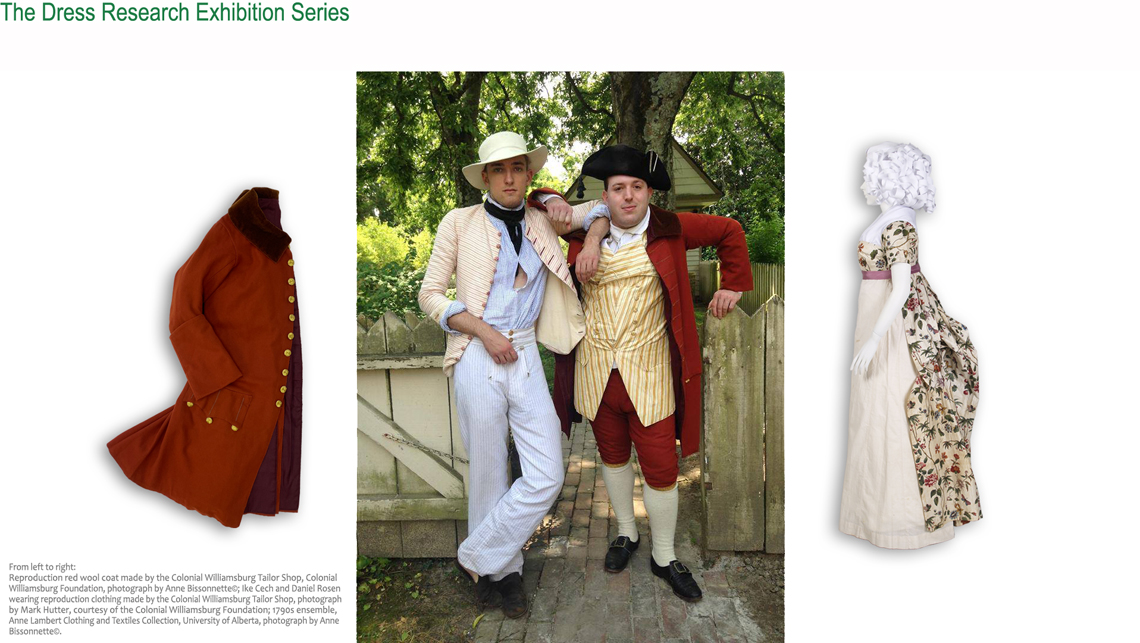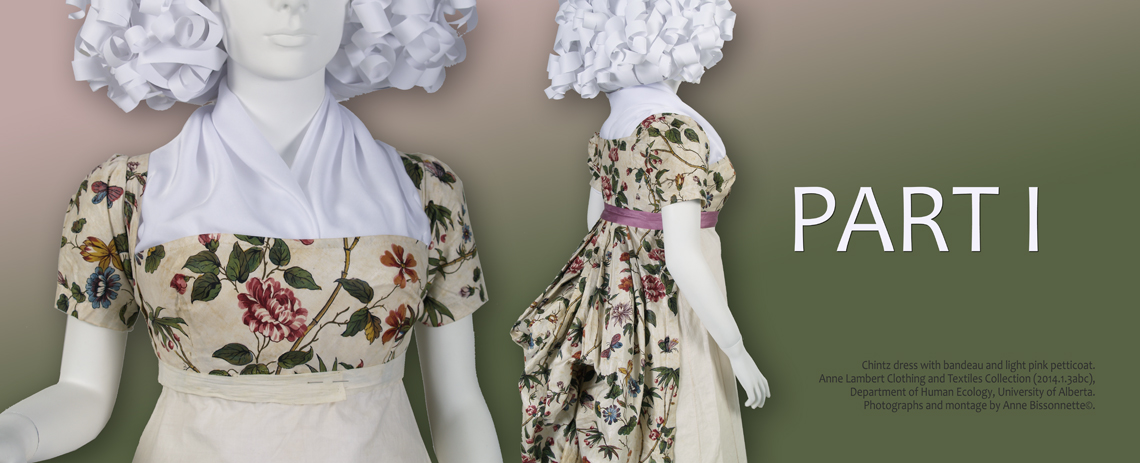
Curators
Anne Bissonnette, PhD, Associate Professor, Material Culture and Curatorship, and Curator, Anne Lambert Clothing and Textiles Collection, Department of Human Ecology, University of Alberta
Josée Chartrand, MA, Assistant Professor, Department of Theatre, MacEwan University
Katelin Karbonik, MA
INTRODUCTION
Dress history is often viewed by the general public through outlets such as film and theatre.[1] In most cases, theatrical costume design is done without strict historical accuracy in mind, but this is seldom understood by audiences who often have a hard time distinguishing fact from fiction. The study of dress outside of stage and screen is also under-acknowledged. What can we learn from historical clothing artifacts and how is this knowledge used? The series Dress & Escapism aims to provide answers to these questions by exploring different aspects of dress history and dress interpretation. From rigorous observations and reproductions of museum artifacts to the artistry of costume design, we explore sartorial expressions and their potential effects on the audience.
In the words of Shakespeare, “All the world’s a stage,” but the stories we tell may be carefully crafted by the garments worn.[2] Stage and screen performances are collaborative efforts that create visual microcosms, which typically deviate from historical accuracy in favour of aesthetics more easily understood by contemporary audiences. Dress is a non-verbal form of communication used by skilled costume designers. A young man in an elaborate 18th-century style ruffled shirt, coat, and knee breeches can easily be read as a prince: there is very little need for historically accurate wigs, posture or stylistic rigor for the message to register. In many cases, adhering strictly to historical accuracy can detract from character development, registering as old-fashioned or even absurd to modern eyes. Current fashion and aesthetics also impact the design of “historical” productions, and many successful dramas, such as Downton Abbey, in turn, affect audiences’ collective imaginations and understanding of history. Our constructed past is alluring yet worthy of re-assessment.
Clothing has the power to speak of the social, cultural, and political but this message is often fragmented. Nonetheless, dress research can lead to a wide array of insights on apparel and surface design and technology, textile production and trade, and museum practices.[3] Museum artifacts function as finite time capsules that can be read in different ways. In an exhibition setting, a series of objects can be curated to communicate certain information. The exhibition series will address research biases, reflexive practices, and experiential approaches not often used in academia, such as learning about history through the making process. This may allow those outside the field to understand the challenges of studying dress artifacts, the subjectivity of the process, and the creativity involved.
Anne Bissonnette
Josée Chartrand
Katelin Karbonik
[1] Malgorzata J. Rymsza-Pawlowska, "Broadcasting the Past: History Television, ‘Nostalgia Culture,’ and the Emergence of the Miniseries in the 1970s United States,” Journal of Popular Film & Television 42, no. 2 (2014): 81-90.
[2] William Shakespeare, As You Like It, Act 2, Scene 7, Line 139.
[3] Anne Lambert Clothing and Textiles Collection Website, https://clothingtextiles.ualberta.ca/ (accessed July 31, 2019).
CLICK ON THE BANNERS BELOW
TO ACCESS THE EXHIBITIONS
Dress Artifacts & Curatorial Practices
A Virtual (and Evolving) Exhibition
Human Ecology Department
University of Alberta
Anne Bissonnette, Lead Curator
Josée Chartrand and Katelin Karbonik, Contributing Curators
June 30, 2020 – June 30, 2021
In Part 1, half of the objects exhibited are historical artifacts from the Anne Lambert Clothing and Textile Collection, while the other half are reproductions used to better understand historical dress and to push boundaries of knowledge in the field of dress history. The six case studies help present different avenues of study and the strengths and limitations that go into the research and the visual display of objects.
A large part of the work presented in Part 1 was conducted in the Department of Human Ecology at the University of Alberta. Many investigations into different facets of fashion and dress are the result of graduate student work: some as part of their own research and others as part of graduate assistantships under Dr. Bissonnette. The Social Sciences and Humanities Research Council of Canada provided funding for Dr. Bissonnette's project entitled “A Revolutionary Decade: Fashion & Material Culture in the 1790s.” The aesthetic and embodied changes in late eighteenth-century fashion are thus a focus of the exhibition.
Because of the COVID-19 pandemic, the exhibition will be presented online. This has changed the nature of the project to take advantage of what virtual exhibitions can offer. We seek to reach a larger audience that can help propose new ideas to address diversity in the display of dress, present new historical evidence, or bring in new perspectives allowing the exhibition to evolve. For the next year, the website will evolve as feedback is received and new evidence emerges and experiences are shared.
Performance of Identity
through Drag and Burlesque Costume
A Virtual Exhibition
John and Maggie Mitchell Art Gallery
MacEwan University
Josée Chartrand, Lead Curator
January 26, 2021 – March 27, 2021*
Dress & Escapism: Performance of Identity Through Drag and Burlesque Costume explores the relationship between performance costume and identity within the highly emotive art forms of drag and burlesque.
The exhibition showcases dramatic examples of social and political art from the stages and clubs of Edmonton by individual performers (Holly Von Sinn, Claudia Hartout, Rusty Strutz and Darrin Hagen), performance companies (Guys in Disguise and Send in the Girls Burlesque) and film (Dirt City Films).
This exhibition invites visitors to look closely at costumes typically only seen at a distance in performance. A closer view brings details into focus that may otherwise get overlooked. Tears, stains and missing and loose sequins are all part of a costume’s life, and these imperfections are evidence of the rigours that these artists not only put their costumes through, but also their bodies. Viewed up close, the construction and designs of these costumes also come into focus. The under structures used to shape and pad out a drag silhouette are seldom seen, but are fundamental to the illusion of drag. Similarly, the featured burlesque costumes make visible the remarkable sturdiness and design of their rapid release closures—they must remain fixed in place until the artist chooses to release them, allowing the artists to tease their way out of their costume with ease.
While the exhibition highlights how construction details and wear uniquely illustrate the life of the featured costumes, the aesthetic artistry of the garments is its primary focus. Each costume tells a story unique to the persona of the artist who wore it.
As part of an exhibition series exploring the communicative power of clothing through different mediums of dress, Performance of Identity Through Drag and Burlesque Costume demonstrates the expression of self through costume. As a whole, the series aims to explore what can be learned from clothing and how that knowledge can be applied through different aspects of dress, history and dress interpretation. The foci of Part 1 centered on “[t]he aesthetic and embodied changes in late eighteenth-century fashion” through the exhibition of historical artifacts and reconstructed garments of that time. While seemingly unrelated to the drag and burlesque foci of Part 2, they both seek to explore the “sartorial expressions” of each genre “and the potential effects on [their respective] audience.”
* Exhibition dates contingent on public health/university guidelines.
The curatorial team would like to thank the following individuals and institutions for their help and support:
- Mark Hutter, Master Tailor at The Colonial Williamsburg Foundation, for the main image of the series.
- Carolyn Jervis at the John and Maggie Mitchell Art Gallery, MacEwan University.
Support for the exhibition was also provided by a KIAS Dialogue Grant from the Kule Institute for Advanced Study and a CIP Artist Project Grant by the Edmonton Arts Council and the City of Edmonton.



This exhibition also draws on research supported by the Social Sciences and Humanities Research Council. The following individuals have contributed to Dr. Bissonnette’s research thus far: Josée Chartrand, Meg Furler, Peggy Isley, Katelin Karbonik, Patricia Siferd, and Sarah Woodyard.



